Hip AVN is the death of bone tissue as a result of a lack of blood supply. It’s also called osteonecrosis, and it can lead to small fractures and bone collapse. Typically, the procedure takes months to years.
A fractured bone or a dislocated joint can obstruct blood flow to a section of bone. Moreover, excessive alcohol intake and prolonged use of high-dose steroid medications are associated with avascular necrosis.
Anybody may be impacted. Yet, individuals aged between 30 and 50 experience the highest occurrence rate of the condition.

Overview
What is Hip AVN?
Hip AVN, Avascular necrosis, also known as osteonecrosis or ischemic bone necrosis, occurs when bone tissue dies because of a reduced blood supply. If left untreated, it can lead to bone collapse, with the hip being the most commonly affected area, although it can also occur in the shoulder, knees, and ankles.
Symptoms & Causes
What are the signs of avascular necrosis, Hip AVN?
It could take weeks or even months before symptoms become noticeable. Here are some gradual symptoms that might suggest avascular necrosis:
- Intermittent pain that comes and goes when pressure is applied and relieved from the bone.
- Progressive pain and stiffness in the joints.
- Decreased range of motion.
- Limping in cases of avascular necrosis affecting the hips or knees.
- Challenges with activities like climbing stairs, standing, or walking.
Causes
What leads to avascular necrosis?
A lack of blood flow to bone tissue, typically triggered by bone fractures or diseases, is the primary cause. Around 20% of avascular necrosis cases occur without an apparent trigger.
The causes of avascular necrosis include:
- Traumatic avascular necrosis: This can occur following bone fractures or joint dislocations.
- Nontraumatic avascular necrosis: Resulting from illnesses or medical conditions that impede blood flow to bone tissue. Nontraumatic avascular necrosis often affects corresponding bones on both sides of the body. For instance, if the right shoulder experiences avascular necrosis, it’s probable the left shoulder will be affected as well.
Do bone fractures induce traumatic avascular necrosis?
Certain fractures pose a higher risk. For instance, about 20% of hip dislocations result in avascular necrosis.
What health issues prompt nontraumatic avascular necrosis?
Various conditions or therapies can trigger it:
- Osteoporosis; elderly women and some men might experience spontaneous avascular necrosis of the knee.
- Blood disorders like sickle cell anemia.
- Diabetes.
- Cancer treatments such as radiation therapy.
- Decompression sickness in scuba divers.
- HIV.
- Lupus.
- Organ transplants.
Avascular necrosis is linked (Medical conditions) with:
- Pancreatitis
- Gaucher’s disease
- HIV/AIDS
- Systemic lupus erythematosus
- Sickle cell anemia
- Decompression sickness (divers’ disease)
- Specific cancers like leukemia
Diagnosis of Hip AVN
Diagnosing Hip AVN with the help of following tests:
- Bone scan: Radioactive material injected into a vein highlights bone injuries or healing on images.
- MRI, CT scan
- X-rays.
Management & Treatment
How is Hip AVN managed by healthcare providers?
Treatment varies based on bone damage extent. For minor bone damage in non-weight-bearing bones, options may include:
- Cold or Heat therapy,
- Rest,
- NSAIDs,
- Physical therapy to alleviate joint tenderness and enhance motion, and walking aids like canes or crutches.
How is advanced avascular necrosis treated?
Typically, surgery is necessary. Options include
- Core decompression, where small holes are drilled into the affected bone to enhance blood flow, possibly combined with injections or bone grafts.
- Alternatively, Joint replacement surgery may be performed, replacing the damaged joint with an artificial one. Hip Replacementand knee replacements have a high success rate, alleviating pain and restoring mobility in about 95% of cases.
Prevention
How to avoid avascular necrosis?
While prevention isn’t always feasible, you can lower your risk by:
- Quitting smoking.
- Reducing alcohol consumption.
- Monitoring cholesterol levels.
- Consulting your healthcare provider about tapering corticosteroid doses if taken for a chronic condition.